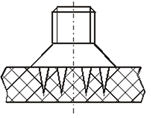Application of erosion dimensional treatment methods for creation transversal fasteners in “metal-composite” joints
DOI:
https://doi.org/10.20535/2521-1943.2022.6.3.264786Keywords:
transversal fastening elements, “metal-composite” joint, micropins, electro-erosion dimensional treatment, labor intensity, energy consumptionAbstract
At design of high-loaded units of engineering objects, especially such as articles of aero-space engineering, the problem of creation of reliable joints between metal and composite articles having predefined strength and ability to fulfill given functions appears.
Development and grounding of selection of structural-manufacturing solutions of “metal-composite” joints with transversal fastening elements is selected as the objective of studying.
As the object for studying possible structural-manufacturing solutions of “metal-composite” joints that use transversal fastening elements which are embedded to composite and attached to metal article or produced on its surface. Three types of fastening micro-elements are considered, i.e. pyramidal monolithic, cylindrical and sheet-formed, also different technologies of fastening elements production are considered too.
Mass of typical flat article with micro-pins at given load-carrying ability of “metal-composite joint” was esti-mated for above-mentioned types of micro-fasteners.
Such quantitative indexes of manufacturability as labor-intensity and energy consumption of fastening elements production were considered as results of studies.
Approach to comparison methods of fastening elements manufacturing is suggested. This approach is based on analysis of correspondent numerical specific indexes of labor-intensity and energy consumption. These indexes are com-pared for micro-pins which are assumed to be produced of aluminum, titanium alloys and stainless steels.
Distinctive feature of suggested model of analysis is taking into consideration both main and auxiliary techno-logical operations, which influence significantly on manufacturing labor-intensity and duration. Process of classical milling with cylindrical and disc mills is compared with up-to-date methods of electro-erosion cutting with wire.
Recommendations for selection shape, type and arrangement scheme of micro-fasteners on article surface and exact manufacturing process of micro-pins production at given material are formulated as conclusions.
References
- Ya.S. Karpov, Joints of articles and units made of composites, (In Russian), Kharkiv, Nat. Aerosp. Univ. “KhAI”, 2006.
- V.V. Vorobey, O.S. Sirotkin. “Joints of structures made of composites” (in Russion), Leningrad, Machine-building, 1985.
- Anna Galińska, Cezary Galiński. “Mechanical Joining of Fibre Reinforced Polymer Composites to Metals – A Review. Part II: Riveting, Clinching, Non-Adhesive Form-Locked Joints, Pin and Loop Joining”, Polymers, Vol. 12(8). Issue 1681, pp. 1–40, 28 July 2020. DOI: https://doi.org/10.3390/polym12081681
- B. Schornstein et al., “Manufacturing Principles for Z-Pin Reinforced FRP Composite Laminates in the Case of Bolted Joints”, Lightweight Design worldwide, Issue 10(3), pp. 28–33, June 2017. DOI:10.1007/s41777-017-0025-1
- M. Azizur Rahman et al., “Development of micropin fabrication process using tool-based micromachining”, Int J Adv Manuf Technol, Vol. 27, pp. 939–944, 2006. DOI: 10.1007/s00170-004-2270-9
- S. Job et al., Joining of Fibre-Reinforced Polymer Composites: A Good Practice Guide, Grazebrook Innovation: Oxford, UK, 2020.
- Z. Dawei et al., “Review on joining process of carbon fiber-reinforced polymer and metal: Methods and joining process”, Rare Metal Mater. Eng., 47, pp. 3686–3696, 2018. DOI: 10.1016/S1875-5372(19)30018-9
- A. Pramanik et al., “Joining of carbon fibre reinforced polymer (CFRP) composites and aluminium alloys–A review”, Compos. Part. A Appl. Sci. Manuf., 101, pp. 1–29, 2017. DOI: 10.1016/j.compositesa.2017.06.007
- Z. Dawei et al., “Review on joining process of carbon fiber-reinforced polymer and metal: Applications and outlook”, Rare Met-al Mater. Eng., 48, pp. 44–54, 2019.
- M. Gude et al., “Development of novel form-locked joints for textile reinforced thermoplastics and metallic components”, J. Mater. Process. Technol., 216, pp. 140–145, 2015. DOI: 10.1016/j.jmatprotec.2014.09.007
- J. Altmeyer et al., “Microstructure and mechanical performance of metal-composite hybrid joints produced by Fric Riveting”, Compos. Part. B Eng., 81, pp. 130–140, 2015. DOI: 10.1016/j.compositesb.2015.06.015
- R. Matsuzaki, T. Kanatani and A. Todoroki, “Multi-material additive manufacturing of polymers and metals using fused filament fabrication and electroforming”. Addit. Manuf., 29, 100812, 2019. DOI: 10.1016/j.addma.2019.100812
- Benjamin Schornstein et al., “Manufacturing Principles for Z-Pin Reinforced FRP Composite Laminates in the Case of Bolted Joints’, Lightweight Design worldwide, Issue 3/2017.
- Ik-Hyeon Choi et al., “New Manufacturing Method of Z-Pinned Composite Laminates”, in 51 st AIAA/ASME/ASCE/AHS/ASC Structures, Structural Dynamics and Materials Conference, April 2010. DOI: 10.2514/6.2010-3133
- Sodick Co. LTD. Available: https://sodick.sodicom.biz/ru/?gclid=Cj0KCQjwqPGUBhDwARIsANNwjV4jwGaX4yxXajbzpFZqS5bLJmyAXH_KI4kx3p4xsSDH-UvMqAX_XfoaAizFEALw_wcB
- Mitsubishi Electric Corporation. Available: https://www.sodick.co.jp

Downloads
Published
How to Cite
Issue
Section
License
Copyright (c) 2022 Ігор Тараненко

This work is licensed under a Creative Commons Attribution 4.0 International License.
Authors who publish with this journal agree to the following terms:
- Authors retain copyright and grant the journal right of first publication with the work simultaneously licensed under CC BY 4.0 that allows others to share the work with an acknowledgement of the work's authorship and initial publication in this journal.
- Authors are able to enter into separate, additional contractual arrangements for the non-exclusive distribution of the journal's published version of the work (e.g., post it to an institutional repository or publish it in a book), with an acknowledgement of its initial publication in this journal.
- Authors are permitted and encouraged to post their work online (e.g., in institutional repositories or on their website) prior to and during the submission process, as it can lead to productive exchanges, as well as earlier and greater citation of published work




